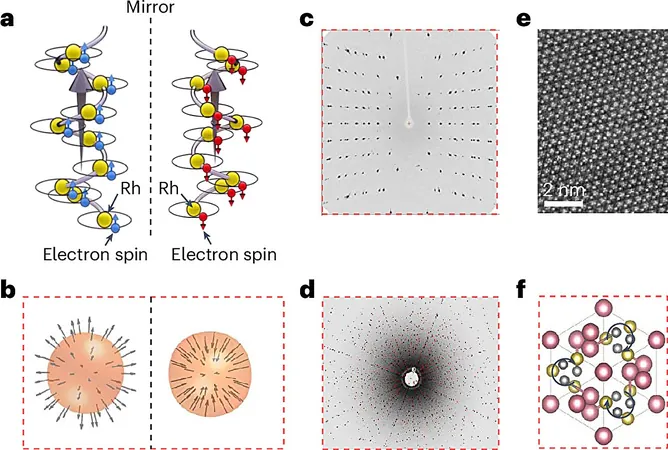
Revolutionary Spin-Powered Crystals Unlock New Era in Clean Hydrogen Production!
2024-11-25
Author: Rajesh
Introduction
In a groundbreaking advance for sustainable energy, an international research team has unveiled a game-changing method to enhance the water splitting process—the key to producing clean hydrogen. This innovative process involves breaking water molecules into hydrogen and oxygen, a crucial step in the quest for renewable energy sources. However, the journey has been clouded by the sluggish chemical reactions associated with oxygen evolution, making hydrogen production inefficient and economically burdensome.
The Role of Topological Chiral Crystals
Enter the extraordinary world of topological chiral crystals! The researchers, including experts from the Max Planck Institute and the Weizmann Institute of Science, have discovered that these specially structured crystals, with unique left or right-handed atomic arrangements, can dramatically transform the water splitting process.
Research Findings
Their astonishing findings, published in the esteemed journal Nature Energy, reveal that these crystals—composed of rhodium and elements such as silicon, tin, and bismuth—exhibit remarkable capabilities in manipulating electron spin. This special quantum property significantly accelerates electron transfer, allowing for a more efficient generation of oxygen and, in turn, boosting the entire chemical reaction responsible for producing hydrogen.
Expert Insights
Dr. Xia Wang, the lead researcher at the Max Planck Institute for Chemical Physics of Solids, described the new materials as "essentially quantum machines." He emphasized the breakthrough, stating, “By leveraging the unique spin properties of electrons, we've developed a catalyst that outperforms traditional materials by an astonishing factor of 200.”
Future Directions
While the current catalysts do involve some rare elements, Prof. Binghai Yan confidently noted that the team is actively exploring design adaptations to develop highly efficient and sustainable alternatives. Their commitment to innovation not only addresses current limitations but also sets the stage for future advancements in green technology.
Conclusion
The implications of this research are monumental. By optimizing hydrogen production—making it faster and more cost-effective—these chiral crystals could help propel us toward a clean energy future, less reliant on fossil fuels and more aligned with the global sustainability goals. This is not just a scientific triumph but a pivotal shift in the renewable energy landscape.
Final Thoughts
As the world continues to grapple with energy challenges, the integration of cutting-edge quantum physics into practical applications like hydrogen production may very well hold the key to sustainable energy solutions—and a cleaner planet for generations to come!



 Brasil (PT)
Brasil (PT)
 Canada (EN)
Canada (EN)
 Chile (ES)
Chile (ES)
 España (ES)
España (ES)
 France (FR)
France (FR)
 Hong Kong (EN)
Hong Kong (EN)
 Italia (IT)
Italia (IT)
 日本 (JA)
日本 (JA)
 Magyarország (HU)
Magyarország (HU)
 Norge (NO)
Norge (NO)
 Polska (PL)
Polska (PL)
 Schweiz (DE)
Schweiz (DE)
 Singapore (EN)
Singapore (EN)
 Sverige (SV)
Sverige (SV)
 Suomi (FI)
Suomi (FI)
 Türkiye (TR)
Türkiye (TR)